Sarmeda 1119 g. "The bloody field"
It all started like this ... The troops of the First Crusade in 1099 entered ancient Jerusalem and successfully repelled the attempts of the faithful to knock out the winners from the land they had seized. At the end of the campaign, those crusaders who remained in the Promised Land decided that they, as the masters of the situation, were free to choose any place for themselves and, if necessary, to expand their possessions. Pope Urban II (ca. 10421099), who initiated the crusade, apparently died much earlier than the day when the joyful news of the liberation of Jerusalem of the Holy Sepulcher came to Rome.
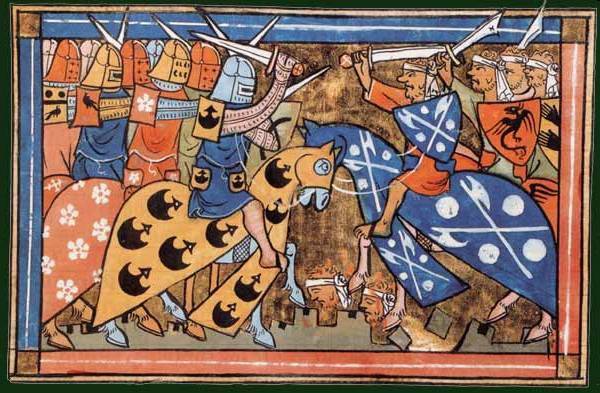
Louis VII and King Baudouin III of Jerusalem (left) battling the Saracens (right). A miniature from the manuscript of Guillaume de Tire, The Outremer Story, 14th century. (National Library of France).
It was clear that the army, of course, carried out the sacred task assigned to the army by Pope Urban II. The ancient city was in the hands of Christians, and it was impossible for Muslims to oust them from there.
At that time, the Latins positions in the region were rather unstable. The troops of the next wave of the crusaders, sent to Jerusalem in 1100-1101. in order to replenish the army of the kingdom with fresh forces, they either died on the way or were confused at a very considerable distance from the target. Moreover, the Byzantines, who initially provided all possible assistance to the crusaders, were disappointed in the movement of "pious pilgrims." The Crusaders, they were also called "Franks", according to the agreement concluded with the Byzantines, they pledged to return to the latter all the conquered territories. However, time passed, and the Franks were not in a hurry to fulfill the contract.
But the Latins themselves were not pleased either by the amount or the quality of the support they received, and they didn’t like the ways in which the Byzantines tried to get the territories that historically belonged to them. All these very unpleasant "little things" distracted Christians from their main task - the war with the Gentiles, or more simply, from conducting continuous military campaigns for expanding the sphere of their rule in Lebanon.
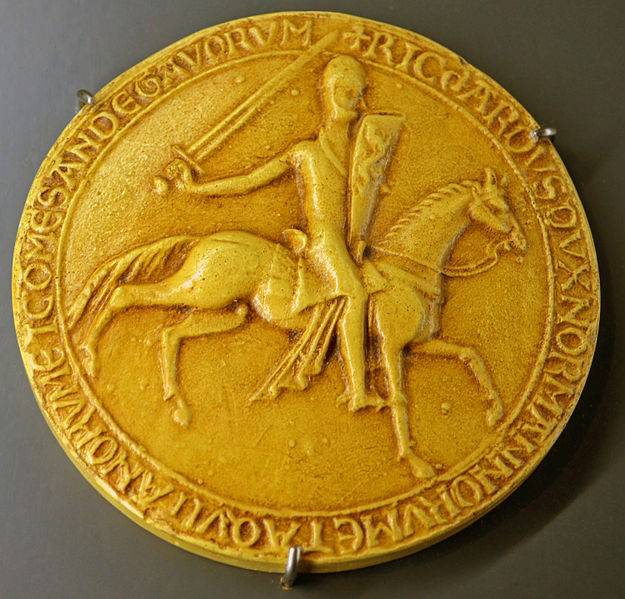
Seal of the King of England Richard I (1195 g.). (Museum of the History of Vendée, Boulogne, Vendée).
Despite a number of failures, including one major defeat, which the Franks suffered under Haran in 1104, in 1100 - 1119. they managed to regain their positions and strengthen their own position both in Judea and in the territories adjacent to it and formerly belonging to Muslims.
In 1104, Acra fell, in 1109, Tripoli. Beirut and Sayda capitulated in 1110 and Tire in 1124.
The military successes of the Crusaders gave them the opportunity to completely dominate large territories, especially given their extreme small number. The coastline was an especially important object under the vigilant control of the Crusaders, making it possible to freely receive unlimited military assistance from Europe. Attempts of the faithful to return the lost territories back in those days were permanent, and therefore the situation around the Promised Land was restless: the activity of the troops on both sides suddenly intensified, then faded.
DISCUSSED UNDER HARRAN
Initially, the crusader army had the glory of invincible because it could crush any troops that opposed it: few could resist the decisive onslaught of cavalry from horsemen dressed in strong armor, covered by mobile, well-armed infantry. At the disposal of the army was also light cavalry, performing its strictly specific task in the army. It served turkopuly ("sons of the Turks"), converted to Christianity, and taken to serve directly in the region. Their armament consisted of bows or spears, armor, if any, was not at all. Equipped with such a straightforward way, they were very mobile. This allowed them to serve as an excellent cover for the cumbersome heavy cavalry of the West.
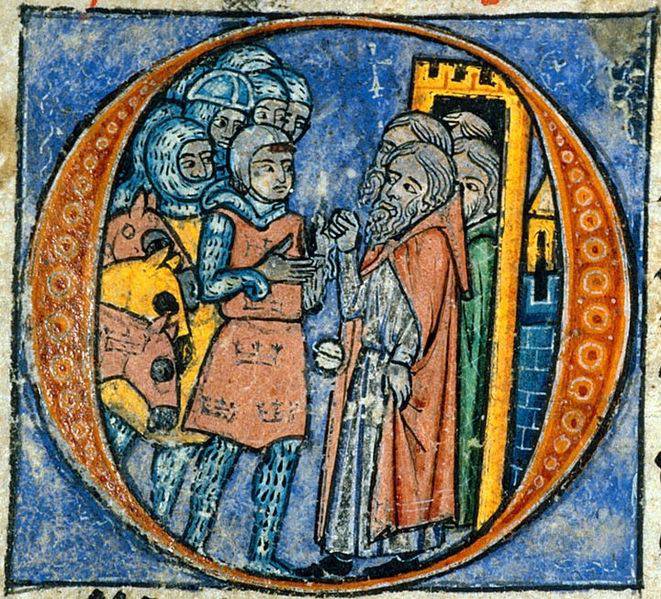
Letter O: the knights of the Outremer. Miniature 1231 British Library.
Initially, this kind of combination successfully worked, while any attempts by the Mohammedans to repel the frontal attack of the knights, for example, to go hand to hand, ended in defeat. And yet, in spite of everything, the Muslim troops began to gain more and more victories over the Crusaders. The battle of Harran was the first battle lost to the Crusaders.
The battle was a consequence of the futile attempts of the Crusaders to storm the city walls of Haran, and also because of the Seljuk attempts to help the fearless garrison of the fortress, who categorically refused to surrender. A series of small clashes, in which the crusaders took the upper hand, resulted in defeat for the latter. One of the units of the Crusader troops took an too rash step: they began to pursue the enemy. Knights got carried away and forgot about caution. For the Crusaders, it ended pitifully: they were surrounded. Some of them were ruthlessly destroyed by Muslims, the other was forced to retreat.

Knight's sword: XII - XIII centuries. Length 95.9 cm, weight 1158, the Metropolitan Museum.
The battle of Harran revealed not only the strengths, but also the weaknesses of the Crusader army, and the Muslims learned an important lesson: you can defeat the crusaders if you know all the weaknesses and strengths of the enemy, to be able to analyze this information and make the only right decision. In addition to the military, this battle yielded certain political results. The Byzantines did not fail to take advantage of the situation to return the former territories.
And yet, despite everything, the Crusaders gradually managed to expand their territories, despite the ongoing conflicts with their neighbors. With the death of Radwan Aleppsky in 1113, a period of relative calm began. At that time, the main provinces of the crusaders were Edessa, where Baudouin II (1100 - 1118), Tripoli of Pontius (near 1112 - 1137) and Antioch ruled. Roger of Salerno was the regent of Antioch from 1112, with juvenile Boemont II (1108 - 1131).
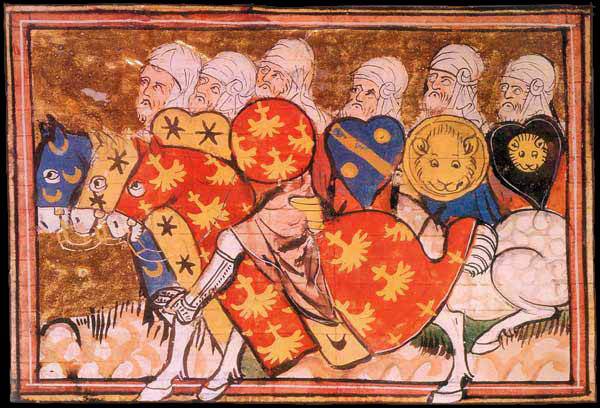
Saladin's army opposes Christians. A miniature from the manuscript of Guillaume de Tire, The Outremer Story, 14th century. (National Library of France). As you can see, even centuries after Sarmed, European miniaturists did not care much about the exact depiction of their opponents.
Taking Azaz allowed the Crusaders to freely move on to Aleppo. Of course, the reaction of the Muslims was adequate to the actions of the Crusaders. In 1119, the ruler of Aleppo Ilgazi led his troops into the principality of Antioch. Roger of Salerno was strongly advised not to hurry and wait for help from the Count Pontius and from Baudouin II, who had recently become king of Jerusalem. But the prince for unknown reasons did not wait for reinforcements, but decided to act independently. Apparently, the situation in which the “delay of death is like” was formed in such a way that it forced the prince to act quickly and decisively.
INSTALLATION OF FORCES
Roger with the army took a position near Arta, near Antioch, where Patriarch Bernard of Valance (de Valance) served God, who advised the prince not to take any action until the approach of aid. Before the start of the campaign against Antioch, Ilgazi was forced to strengthen his army from the fortress of Arta, otherwise the army would have been threatened with a rear blow from the army of Roger.
Patriarch Bernard continued to insist on a waiting position, was categorically against the offensive and demanded that Roger “sit still” and wait for help outside the walls of the fortress.
Roger did not like this situation. Unfortunately, he overestimated his own capabilities and did not take into account the balance of forces of the enemy. Such short-sightedness turned to defeat the Crusaders, who took “not by number, but by skill,” winning in battles with much superior enemy forces, showing all their skills in battle and applying in practice the brilliant knowledge of military affairs. If you turn to history, you can find several examples on the basis of historical documents, showing how approximately also the British troops fought in India at pack time. There, too, everything was about the same: the army in the minority defeated the enemy with just one decisive throw.
Two factors played into the hands of the British: firstly, they had excellent weaponsand secondly, their military training was much higher than that of the Indians. Yes, and the glory of the invincibility of their army was far ahead of the troops. But in this situation, Roger had nothing to boast about. Apparently, equipped his army was not enough, and besides, it was not as desperate as the army of Muslims. Yes, and the defeat at Harran helped the faithful to finally establish themselves in the opinion that the Crusaders can and should be beaten.
"ON THE BOTH SIDE OF BARRICADE ..."
Roger of Salerno commanded an army almost in 3700 people, of whom 700 were equestrian knights and “gendarmes”, the other three thousand were Turkopules and infantry. The Crusaders and the “gendarmes” were armed with long spears and swords, and their body was defended by heavy and durable chain mail.
"Castle of the Knights" - Crac des Chevaliers.
Infantry and turkopuly supported the main shock forces of the army, and also served as a reliable cover for the knights, both in the camp and on the march. They did not have high combat skills, and this allowed the military elite to look at them with contempt, considering them to be the second grade in the military hierarchy. However, they could be understood, because in a battle, it was the knights and their ignoble mounted “squires” from the heavy cavalry units that were the force on which the heaviest and most responsible part of the battle lay. The infantry in the army was generally considered a burden, an unnecessary element, and held it only as a moving obstacle, a living shield, behind which the cavalry could group before returning to attack.
The Muslim cavalry was equipped more simply than the knights cavalry, but its advantage was in excellent combat training. Here was a desperate determination, and experience, and excellent possession of their own weapons (if necessary, horsemen could use both spears and bows). The cavalry used various tactical tricks in the conduct of the battlefield: without incurring losses, it exhausted the enemy army so much that further combat operations became simply impossible.
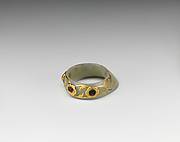
Ring of the eastern archer XVI - XVII century. Metropolitan Museum. Jade, gold. Of course, the time is different, but the difference is quite small. Rather, it simply does not.
The military successes of the Muslim army were the result of the coordinated actions of the whole army, the strict observance of orders of command, and iron military discipline. The exact quantitative composition of the Moslem troops is unknown, but there is an assumption that superiority over Christians was calculated several times. Thus, the opposing troops differed significantly from each other.
Ambush At Al-Atariba
So, Roger of Salerno launched a campaign to meet the Muslim army. Reaching the pass called Sarmed, Roger learned that one of the Christian forts, al-Atarib, was under siege. And Roger decided to help those in trouble. He equipped a small detachment under the command of Robert (Robert) du Vieux-Pont to lift the siege. Provident Ilgazi, feeling how the meeting with the Crusaders could end, ordered him to retreat. Du Vieux-Pont, having liberated the fortress, began to pursue the enemy along with the garrison.
RETREATING ANYTHING NOT DEFEAT
It should be noted that the retreat of the Muslims was not forced; it was a cunning trick that was often used by the Muslim armies in order to exhaust the enemy and then destroy it. In former times, the word "caution" was synonymous with the word "cowardice." And if the commander did not go in the forefront of the assault, he quickly lost their confidence, because he was considered a coward. It turns out that Robert had no choice but to chase the enemy, although perhaps he knew about Ilgazi’s cunning tactics.
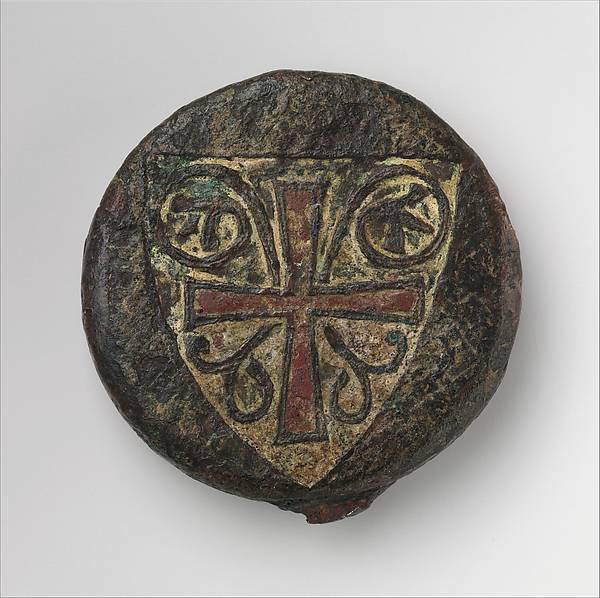
The back of the top of the sword of the crusader De Dre. Metropolitan Museum.
As you can see, the detachment of Robert, pursuing the Muslims, went farther and farther from the fort, losing more and more chances with each passing minute to return to the fortress in case of mortal danger. At the same time, Ilgazi, watching him all this time, decided to move from retreat to attack. As stated, the discipline in the Muslim army was much higher than that of the Crusaders, so Ilgazi’s order to attack was carried out without question, and his army launched a decisive offensive and quickly gained the upper hand over Robert’s army. Robert's unblocking detachment was rendered harmless, and this became a kind of prelude to the battle with the main army of the Crusaders.
ON THE EVE ...
On the night of 27 on 28, June, the Muslim army took up new positions and surrounded the camp with crusader troops. Roger, realizing that the battle could not be avoided, began to prepare for the start of the battle. First of all, he broke his army into three "battles" (batailles, "battles"), taking such a division of troops from Western Christians. Two regiments were headed by Geoffroy Monk and Guy Fresnel, and one led by himself.
In the camp of the Muslims was their own training. Before the battle, the learned husband, Abu-al-Fadl ibn-al-Hashshab, turned to the brave warriors, who also wished to participate in such a noble and worthy man's work. For the battle, he wore military service, although he always wore a turban of qadi. He spoke fiercely and heartfelt, stressed the importance of the upcoming battle and spoke a lot about the historical mission of the soldiers in this battle. Calling on their feats of arms, Abu al-Fadl ibn al-Hashshab expressed his confidence in the imminent victory over the crusaders, which was to bring glory and honor to the soldiers of their glorious troops. The speech of the great husband was so penetrating and piercing that at the end of it, tears came out in front of many.
And DREAMED FIGHT ...
Inspired by such ardent speeches, Muslims rushed to the attack. But good luck was on the side of Roger of Salerno. Crusaders fought desperately, it brought them success at first. Muslims bet on a quick victory after a single attack was unacceptable. Therefore, thanks to the excellent discipline and faith in the success of the battle, the Muslim soldiers carried away the failure in the army easily and did not succumb to despondency.
Meanwhile, the Crusaders, although confidently advancing, began to run out of steam. The riders were tired, the horses, too, all the help was not there: all this taken together began to play its fatal role. Robert de Saint-Lo, who led Turkkopulov, was thrown back by the enemy, to the rear of his troops. Panic broke out among the crusaders. Muslims, meanwhile, acted fairly coolly and harmoniously. The situation was to them only on hand. The army of the Crusaders was broken into pieces, which were quickly taken to the environment, and then easily dealt with them.
Roger of Salerno was in despair. It was necessary to do something with the army ... In order to somehow raise the fighting spirit of the warriors, he decided to gather them around a huge cross decorated with diamonds, the shrine of the Crusaders, but it was too late. There was no one to install: the army was melting before our eyes, and the commander fell, struck by a blow to the face.
There was nowhere to retreat. The Crusaders fought desperately, already surrounded and scattered into small units throughout the field. The Muslims, having a considerable superiority in forces, meanwhile, methodically destroyed the Christian army: first, one group of troops, then another, and so on, until nothing remained of it.
A praying crusader depicted in the “Big Chronicle” by Matthew of Paris. OK. 1250. Thumbnail from the manuscript of the British Library. All his military equipment is clearly visible. So, during the battle of Sarmed the European warriors had even lighter weapons!
The battle was over ... The crusader army was completely defeated. Only two knights of Roger could escape. One of them, lucky Renault Mazuar, was able to get to Fort Sarmed, but, alas, was captured. Several other Christians were also in captivity. Only a small handful of francs could escape and avoid slaughter and captivity. Summing up the battle, we note that almost 3500 of 3700 crusaders died that fateful day for them. Adegsanguinis, or “The Bloody Field,” as historians later called the events of that day.
WHAT WAS NEXT?
And further, in the light of the events that occurred, the frightened patriarch of Antioch, Bernard, hastily began to take measures to strengthen and defend the city walls. The measures were somewhat belated and, most likely, would not have given anything if it were not for the sluggishness of the winner. Had Ilgazi been a little quicker, Antioch would have been taken by one swift rush of troops. But ... History does not like the subjunctive mood. The army of the faithful did not go on the march, having considered, apparently, that a victory over Sarmed was sufficient.
The situation was in favor of the Crusaders, and they did not fail to take advantage of it. King Baudouin II of Jerusalem and Count Pontius managed to send reinforcements, drove the army of Ilgazi from the walls of Antioch, and took it under their protection.
The complete defeat of the army of Roger undermined the forces of Antioch to such an extent that it could not fully recover from it. And although there was still a battle with Azaz in 1125, which ended in a complete victory for the crusaders and allowed them to partially restore their prestige, the myth of their invincibility was dispelled forever.
Chapel in the castle of Krak des Chevaliers.
The Muslims were strengthened in their own ability to defeat the crusaders in battles. Belief in their own strength now helped them win battles and beyond ...
QUANTITATIVE RELATIONSHIP OF THE PARTIES
CROSSONS (approximately)
Knights / Gendarmes: 700
Infantry: 3000
Total: 3700
MUSLIMS (approximately)
Total: 10 000
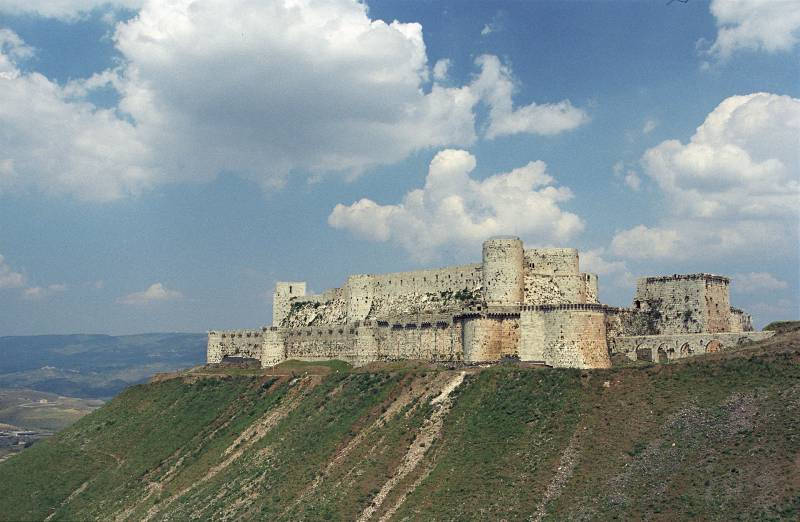
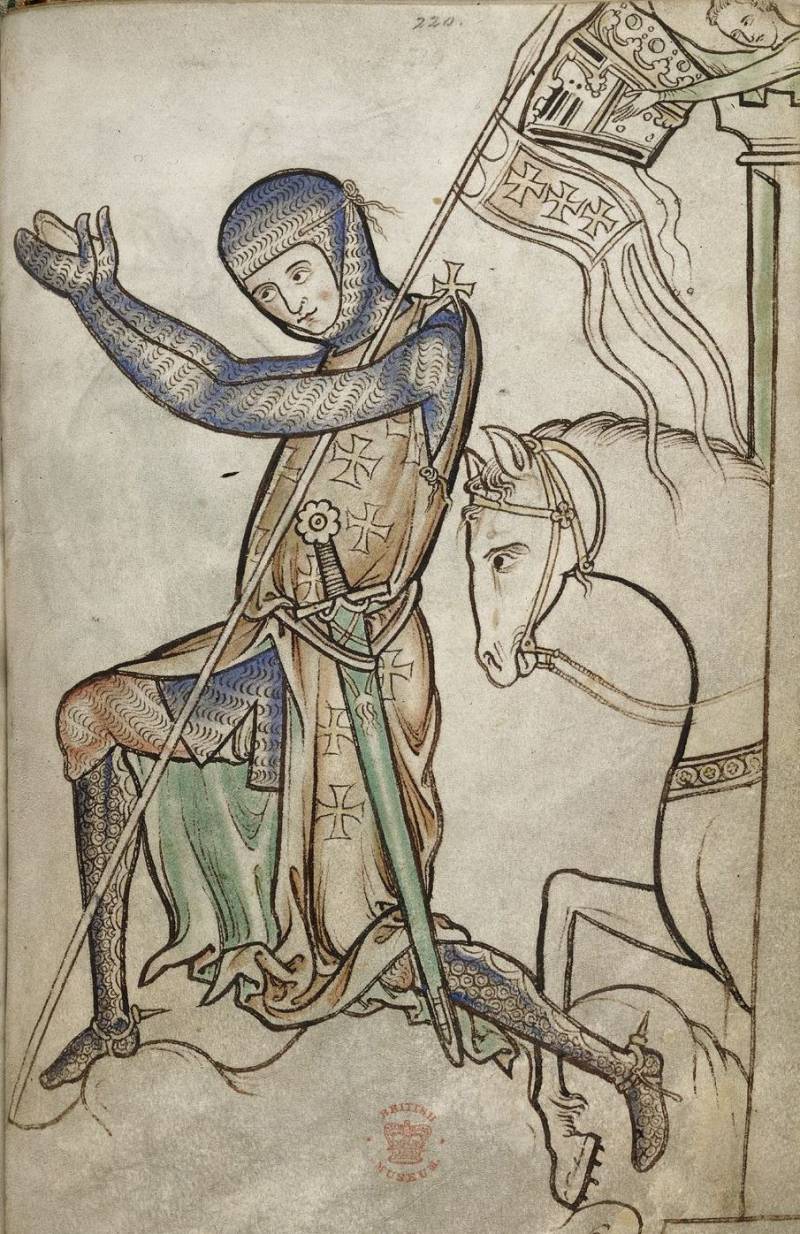
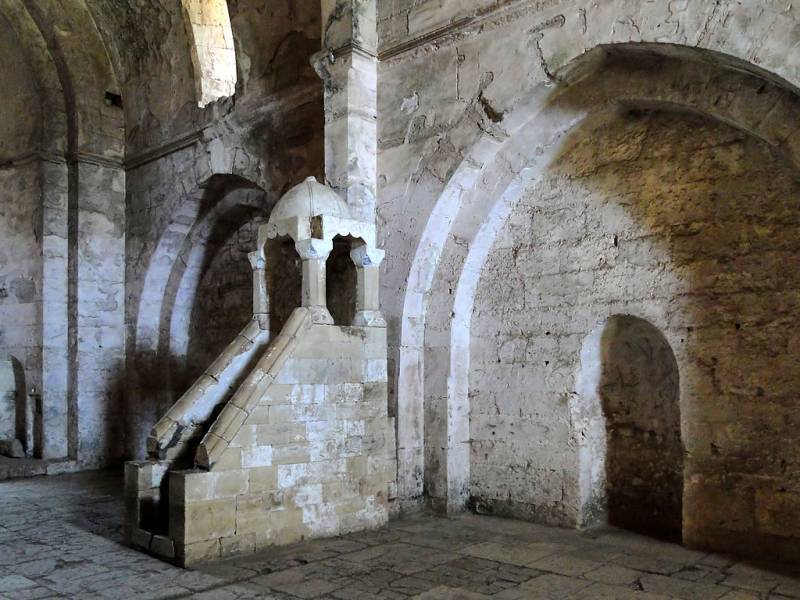
Information